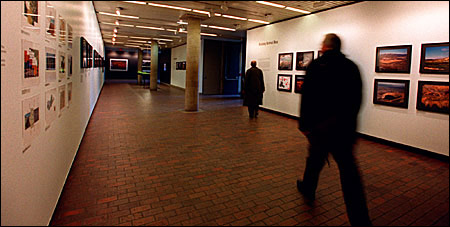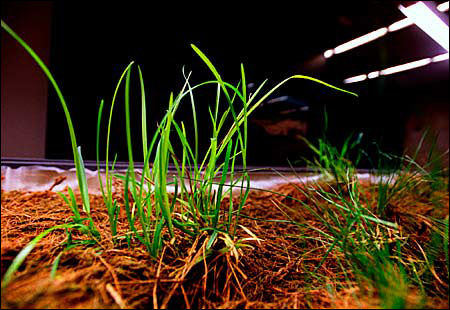Reclaiming the mines of America
GSD exhibition combines spectacular images, digital animations, videos
The average wedding ring contains about two-tenths of an ounce of gold, or $88 worth, according to the latest market prices. It almost seems like a bargain when you consider that in order to produce that much gold, 60 tons of ore must be gouged out of the ground, crushed into small pieces, then leached from its mineral matrix with a weak cyanide compound.

And the costs don’t end there. Large-scale mining operations leave huge, terraced pits in the landscape, mountainous piles of tailings, and pools of water stained with poisonous minerals. The Earth pays dearly whenever a couple says, “I do.”
A new exhibition at the Graduate School of Design makes this point vividly. “Projecting Reclamation in Design,” organized by Alan Berger, associate professor of landscape architecture, combines spectacular aerial photographs of mining operations and their disastrous end results along with maps, charts, diagrams, digital animations, videos, and some other items that bring the subject to life.
A series of tables, illuminated by grow lights, contain live examples of the grasses used to reclaim these devastated Western landscapes. The grasses – hardy species such as Nebraska sedge and hardstem bulrush – are grown on netting made from coconut husks, which biodegrades as the grasses take hold. Known as prevegetated coir sod, the material can be ordered by the square yard and shipped to a site for planting.

Nearby, heaped on a wooden platform, sits a ton of crushed gold ore. One is tempted to pick up a piece and look hard for specks of the precious metal, but it is probably a fruitless exercise. In all this rock, there is no more than one-three hundredth of an ounce of gold, hardly enough to fill a small dental cavity.
The exhibition was scheduled to coincide with a symposium held Dec. 3 to examine ways in which design and mining professionals can work together to address the problem of reclaiming the country’s nearly 500,000 abandoned mines.
“One of the ideas behind the symposium was to start a real dialogue about how we as designers can deal with reclamation sites,” Berger said. “The problem is so big, it affects so many people, that we can’t afford to address these sites just from an aesthetic point of view.”
In fact, as the exhibition suggests, when it comes to reclaiming mining sites, designers may have to take a back seat to some of the smallest, most primitive organisms – bacteria. Viewers can watch electron microscope films of these tiny creatures, identified in a caption as “the planet’s most expert recyclers.” Bacteria are effective in collecting elements like calcium, silica, iron, manganese, and sulfur and transforming them into other forms that can be integrated back into the environment.

“Instead of entering the site as artists or historical interpreters, we could create design conditions for the microbes to do their work. It’s a radical idea. Designers don’t usually take microbial activity into account, but reclamation can be viewed as assisting nature to reassert itself in areas where human intervention has disrupted an ecosystem’s continuity,” Berger said.
The exhibition also recognizes the positive results that have been achieved in reclaiming landscapes disrupted by mining. Since the Surface Mining Control and Reclamation Act was signed into law by Jimmy Carter in 1977, thousands of acres stripped in the process of coal mining have been restored to their “approximate original contour,” as the law requires.
Other types of mining operations are under the jurisdiction of the states, and, in many of these, reclamation is taking place, although the transformation may be slower and less dramatic than in the case of the coal mines. It is important to remember that appearances aren’t everything. As one of the exhibition’s captions states, “The most artificial looking intervention could support nature’s continuity.”
The exhibition also marks the inauguration of the Design School’s Project for Reclamation Excellence, known as P-REX, which critically examines and promotes design as a catalyst for excellence in reclaiming altered landscapes of natural resource extraction through applied research, education, and communications. P-REX is undertaken by the Department of Landscape Architecture and partners with like-minded groups including municipalities, state and federal agencies, universities, foundations, and corporations involved in design, engineering and environmental services, mining, property development, and manufacturing.
One of P-REX’s first projects is a digital simulation movie, running continuously in the exhibition, showing the reclamation of the Montana Tunnels Mine in Helena National Forest. The movie shows a waste dump transformed into a flowering meadow, waste rock slopes that have become a subalpine forest, and a tailings impoundment reshaped into a recreational lake.
P-REX plans to use such films as a way of bringing people to the table and presenting reclamation proposals to people who might have trouble following technically sophisticated graphic materials.
“People living near mines should have a choice about how the postmine land should be,” Berger said.
According to Berger, the extraction of natural resources will rapidly increase over the next millennium as industrial production and consumption globalizes. It has been estimated that by the year 2230, in the United States alone, new mining will create more than 100,000 square miles of land needing reclamation, an area almost as large as the state of Nevada.
“We hope that P-REX will become the epicenter for global leadership on reclamation issues regarding design and reuse of postmined landscapes,” Berger said.




